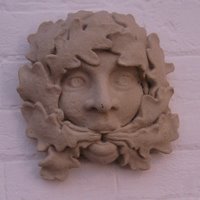The Green Man

In 1939, Lady Raglan wrote an article titled The Green Man in Church Architecture so first used the term for this little known mystical creature, thought to be a symbol of fertility. He comes to us in three basic forms: The Disgorging Head that displays vegetation from its mouth; the Bloodsucker Head that spews vegetation from mouth, nose, ears and eyes and finally the Foliate Head that is simply covered in leaves and other foliage. His grinning image often appears in English villages unexpectedly on a church ceiling, a pew, column or church door. He has been intricately carved, painted, worshipped and reviled but through the centuries, he has remained a favorite topic of stonemasons.
Many believe the origin of the Green Man began in Rome, as there is some evidence of similar figures that can be seen in early Roman culture. What we know is that some time later, Christians adopted the Green Man because we see his likeness in churches throughout the United Kingdom and Europe. In 1154, Augustinian Monks established a church in Yorkshire that was destroyed during the Reformation. Only the nave of the church remains but there is a splendid boss depicting a likeness of the Green Man sprouting a leafy tendril from his eye and yet another from his mouth. In St. Martin’s church, Norfolk, there are three images of the Green Man each showing a different type of foliage.
After the Reformation when so many churches were either badly damaged or in some instances completely razed, it is fortunate that many churches containing the carved imagine have remained. Perhaps it was easier to destroy a beautiful stained glass window than a roof boss, font or screen, which contained a depiction of our mystical creature. One can only imagine the orders to destroy, by cannon fire, anything of beauty in a church. In many instances, they were completely destroyed or left as mere shells of their former splendor. However, many churches were spared and in these we find evidence of the Green Man. No two images are exactly the same, as the stonemasons appear to play with us. In one they portray him laughing and then, in the next instant, depict him in an angry mood.
There is another instance where there is mention of Green Men. During the Stuart and Tudor times, there were certain men in the village whose job it was to keep the crowd back at a safe distance during a procession of royalty or local dignitaries. They wore their hair long and often covered themselves in leaves or vines. Whether this attire was an attempt to intimidate the crowd into compliance, we can only guess, but these men were also known as “whifflers” or “wild men” and also Green Men.
Nowadays, the image of the Green Man can be seen on pub signs throughout England, as he is a very popular character. But, if you plan on visiting England, be prepared to see his grinning face bearing down on you from a church beam, ceiling or corbel watching your every move.



<< Home